WW1 British / Australian Pattern 1897 Infantry Officers Sword Robert Mole 1914
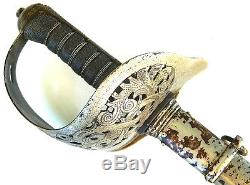
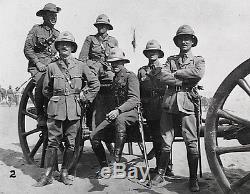
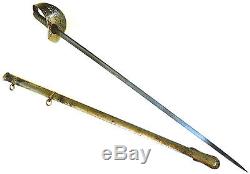
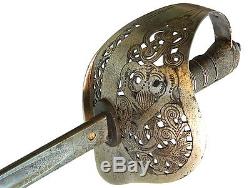
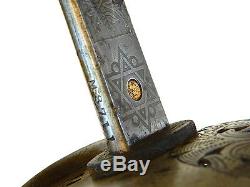
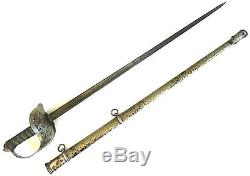
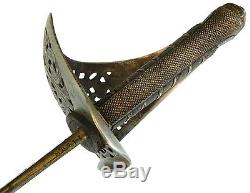
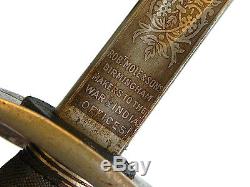
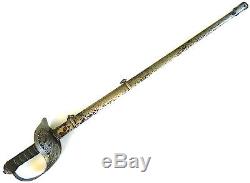
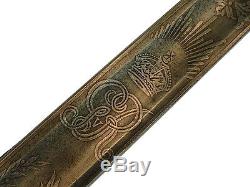
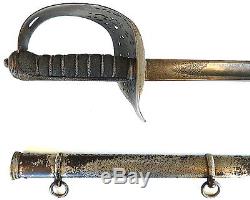
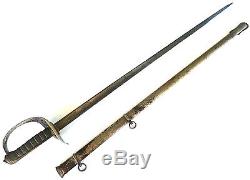

A GOOD HIGH QUALITY ORIGINAL BRITISH / AUSTRALIAN PATTERN 1897 INFANTRY OFFICERS SWORD AND PLATED STEEL SCABBARD. MANUFACTURED BY ROBERT MOLE IN BIRMINGHAM IN 1914. AND ETCHED WITH THE ROYAL CYPHER OF KING GEORGE V.
The Sword, Infantry Officer, Pattern 1897 , as it is officially designated, was the last of a family of 3 swords (Infantry Patterns 1892,1895 and 1897) that were universally recognised as the finest swords ever produced for British and Commonwealth infantry officers. As Brian Robson in his excellent reference work Swords of the British Army writes these swords: with (their) excellent guard and vicious thrusting, blade were unquestionably the best fighting sword(s) ever prescribed for British infantry officers. The only difference between the last two patterns was in the shape of the guard.
The sharp inner edge of the Pattern 1895 guard was found to damage uniforms and as a consequence the Pattern 1897 was introduced fitted with a guard with a turned edge. The Pattern 1897 Infantry Officers Sword has remained in service until the present day. The basic characteristics of the Sword, Infantry Officer, Pattern 1897 were similar to the Pattern 1892 and the Pattern 1895 which had preceded it with the exception of the guard which was an improved version of the design fitted to the Pattern 1895. As with the Pattern 1822 sword there were two versions of the Pattern 1897, a standard and a light, with the light pattern being far less common. In terms of size, there was no difference in length between the two versions, the differences being the girth of the hilt and width of blade.Was optimized for thrusting in line with the common wisdom of the time, which stated that the point will always beat the edge. The new guard was a three quarter basket hilt in plated sheet steel with a scroll pattern inset with the royal cypher and crown that provided very good protection to the officers hand. The grip is sharkskin covered wood bound with silver wire. This particular example is fitted with its plated steel Pattern 1897 Scabbard.. The Australian War Memorial holds.
2 similar swords: RELAWM14942 and RELAWM15946. The second of these belonged to Lieutenant C. Heath, 5 Field Artillery Brigade, AIF who was killed in action in 1917.
Its worth noting that many British made swords supplied to military outfitters in the Dominions. For reference an excellent Australian War Memorial photograph is attached of officers of the 9th Battery, 3rd Field Artillery Brigade AIF taken in Egypt in March 1915, all of who are carrying Swords, Infantry Officer, Pattern 1897. This is a very good example of a British and Commonwealth Sword, Infantry Officer, Pattern 1897 produced by one of the best makers in the Empire. The sword is fitted with a straight etched steel blade in excellent original condition with patination consistent with age and use, the etching is particularly good. The steel three-quarter basket guard with the inset Imperial Royal Cypher (GRV) of King George V (19011 1937) is in very good condition with the usual wear to the plating one sees in swords of this age.
The sharkskin/shagrin covered wooden grips are original and are in very good original condition. The plated steel Pattern 1897 Scabbard is in good condition with a patina consistent with age and use characterised by wear and plating loss.One blade ricasso is stamped with the. ROBt MOLE & SONS, BIRMINGHAM, MAKERS TO THE WAR & INDIA OFFICES. Manufacturers mark while the other is marked with the Damascene star and Prooved cartouche. The steel blade is very clearly. Etched with the usual infantry pattern scrollwork and the Royal Cypher.
(GRV) of King George V (19011 1937). (see pictures) and is as good as any I have seen on a blade of this age. The back edge (spine) of the blade is stamped with a Mole production number from 1914; M8711.
From Australia, a very good First World War British and Commonwealth. Sword, Infantry Officer, Pattern 1897. Fitted with its original Pattern 1897 plated steel Scabbard and marked with the Royal Cypher of the King George V. It has everything you look for in a Pattern 1897; condition, patina, and provenance.A robust and good quality example of First War Pattern 1897, a variant still in service with the Australian and British Armys today. The items I list on ANZACBLADE e-bay are not dual listed on my website of the same name.
The item "WW1 British / Australian Pattern 1897 Infantry Officers Sword Robert Mole 1914" is in sale since Thursday, February 02, 2017. This item is in the category "Collectables\Militaria\1914 - 1918 (WWI)". The seller is "anzacblade" and is located in Griffith, ACT. This item can be shipped worldwide.
- Authenticity: Original
- Country: Britain
- Campaign: World War I
- Product Type: Sword
- Era: 1910s

